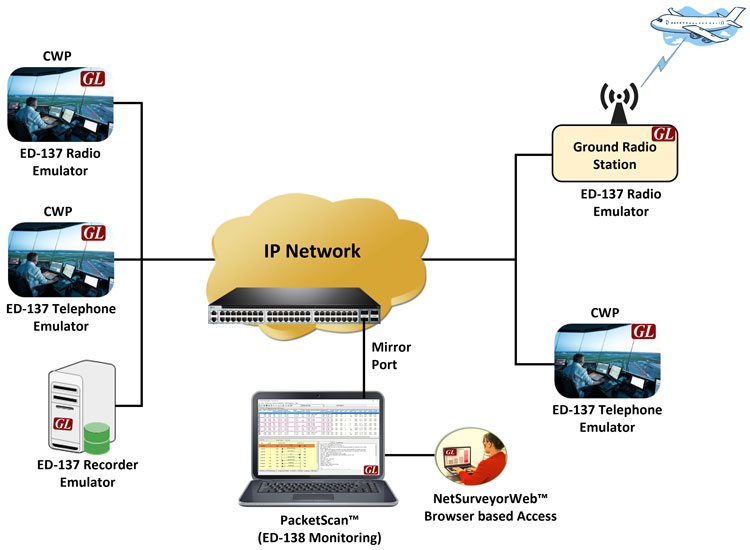Air Traffic Management System Testing with GL's Latest ED-137 Emulators
Welcome to the latest edition of GL’s newsletter! We are excited to announce the latest release of our ED-137 Telephone and Radio Emulators for testing Air Traffic communication systems. These solutions are trusted globally by Air Navigation Service Providers, and manufacturers of VCS, radios, recorders, and gateways. These fully compliant ED-137 emulators support Air-to-Ground and Ground-to-Ground communications, providing a simple and reliable way to test interfaces as Air Traffic Communication systems move to VoIP.

Overview
GL offers advanced testing solutions for next-generation Air Traffic Communications networks, enabling precise emulation and load testing of Controller Working Positions (CWPs), Ground Radio Stations (GRSs), Analog-to-IP converters, and Gateways. Fully compliant with EUROCAE ED-137, these tools evaluate performance, functionality, and timing accuracy. They also support signaling and traffic emulation for Air-to-Ground and Ground-to-Ground interfaces.
GL’s Message Automation and Protocol Simulation (MAPS™) framework supports protocol emulation across Analog, TDM, and VoIP technologies. It emulates ED-137-compliant Radio, Telephone, and Recorder interfaces for testing VoIP-based Air Traffic networks. MAPS™ run on the Windows® operating system and uses the PC’s network interface card to send and receive traffic. All MAPS™ ED-137 emulators support ED-137 B and C, including ED-137C Change 1 and Change 2, with IPv6 compatibility. Validated using EUROCAE’s VOTER tool, they ensure compliance and reliability for functional and load testing of interfaces such as CWP, VCS, GRS, Recorder, and Radio Gateway.
The MAPS™ ED-137 Radio Emulator is for Air-to-Ground testing, with the ability to emulate both GRS and CWPs. It supports signaling procedures such as Push-to-Talk (PTT), SQUELCH, and SELCAL, while enabling multicast and group communications across multiple radios. The emulator is compliant with ED-137B and ED-137C (Change 1 and 2), and scales to support large test scenarios with hundreds of radios. Engineers can also apply impairments to assess system performance under stress, while real-time logs and statistics provide full visibility into system behavior.
The MAPS™ ED-137 Telephone Emulator is designed for testing Ground-to-Ground communications by emulating multiple CWPs and VCS. It validates standard and advanced call scenarios, including routine, priority, instantaneous, and position monitoring. The emulator is fully compliant with ED-137/2B and ED-137/2C, and implements critical addendums such as FAA Legacy Interworking, Override Call, and Voice Call handling. With support for voice and signaling traffic, automation, and detailed analysis, it provides a complete solution for both functional and conformance testing.
In addition to the above emulators, GL’s MAPS™ ED-137 Recorder emulates the recording interface at CWPs, GRSs, and Recorder Servers as defined in ED-137 Volume 4. A single license can emulate hundreds of CWPs or radios and generate bulk Air-to-Ground and Ground-to-Ground recording sessions for load and performance testing. The MAPS™ ED-137 framework allows customization of protocol messages and creation of custom and negative test scenarios. It supports IP impairment emulation, including packet loss, duplication, out-of-sequence delivery, and latency—to verify performance under adverse network conditions. For service quality monitoring per ED-138, it provides detailed voice metrics—including MOS, packet loss, jitter, and latency and supports PESQ and POLQA scoring. All traffic can be monitored with GL’s PacketScan™ and analyzed locally or remotely using the web-based NetSurveyorWeb™ application.
Key Features
MAPS™ ED-137 Radio Emulator
- Supports various RTP audio traffic types including real-time audio, voice file playback, and DTMF signaling
- Support for multiple radio emulation (up to 500 Radios) within single instance of the software
- Support for user-events that can be applied dynamically on an established call (Re-Invite, PTT Priority, Signal Quality Information (SQI), CLIMAX Time Delay, Receive Traffic, Delay Compensation messages (RMM and MAM), Radio Remote Control, Impairments, Play to Speaker, RTP Audio/R2S-Keepalives
- Easy-to-read call flow graphs showing SIP exchanges, headers, and SDP details
- Supports multiple user profiles per node with DSCP values for signaling and voice traffic
- Flexible GRS simulation – Separated (Tx/Rx) or combined
- Define and include non-VoIP keying source parameters in WG67-KeyIn events
- Supports Dynamic Delay Measurement to Transmitters and Receivers using either absolute or relative time
- Advanced PTT Summation and Coupling PTT Summation modes
- Remote operation and automation with Python APIs
MAPS™ ED-137 Telephone Emulator
- Supports a wide range of call types per ED-137/2B and 2C, including Instantaneous Access, Priority DA/IDA, Routine Tactical, Routine Strategic, Routine General Purpose, Position Monitoring (A/G and G/G), and Meet Me
- Supports additional call scenarios like Call Hold, Attended Call Transfer, Unattended Call Transfer, Call Pick-Up, Preset Conference, Broadcast Conference and more
- Provides easy-to-understand call flow graphs of SIP message exchanges with detailed SIP headers and SDP attributes
- Supports hundreds of simultaneous calls and load generation can be automated completely along with traffic
- Portable and easy to configure, ideal for field installation, system setup, testing, and commissioning
- Supports diverse traffic actions, including playback to speaker, send/record audio files, digit/tone generation and detection
- Supports IP address spoofing for each endpoint to generate call using different IP address from a single system
- Remote operation and automation with Python APIs
 Back to Newsletter Index Page
Back to Newsletter Index Page